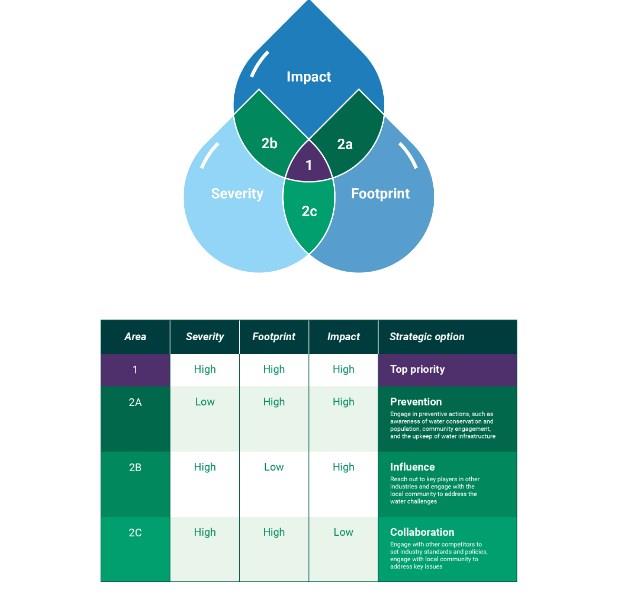by Chengyi Lin and Truke Smoor*
As ESG has become a critical part of company strategy, many leaders have begun to consider how to design roadmaps and actionable plans. Yet, most struggle to make meaningful commitments and act. Looking at the water conservation efforts of Cargill and the World Resources Institute (WRI), we provide a framework to help companies move past the idealisation stage and into action on key ESG issues such as carbon and water.
At 2019’s World Water Week in Stockholm, Truke feverishly took notes during a session based on a company guide that outlined a step-by-step approach on target setting for water. She felt she had finally found the playbook for Cargill’s water strategy.
In 2017, Cargill had listed water alongside climate and land use as a top priority for its sustainability strategy. A dedicated team, including Truke, was tasked with detailing the strategy, setting the targets and coordinating the implementation. However, when she sat down with a director from a leading environmental group and excitedly shared the Cargill vision and her tasks, the response from the director was muted, to say the least. “The scale and the complexity of the initiative is massive. Honestly, I don’t see a path to solving this in the timeline you have put yourself on”, Truke was told.
Post-World Water Week, Truke’s back-of-the-envelope calculation proved that director right. Running a series of comprehensive hydrological studies to set targets could take roughly two years and cost US$50,000. Cargill has already conducted 30 studies to inform its facilities strategy. Knowing that Cargill’s largest impact is in the agricultural supply chain, she then realised she would have to conduct another 270 studies. Even running 10-15 studies in parallel each year, it would take 15-20 years and more than US$15 million to just collect the data for target setting. Of course, this was an impossible ask for any executive committee or board.
Many sustainability leaders at firms with sizable global footprints are experiencing Truke’s struggle. The hydrological study approach may seem agile and inexpensive at a glance. Amplified by the large number of global sites and the complex supply chains in most MNCs, the time, capital and human resources required means it is unrealistic. Beyond water, this struggle also prevents action when firms attempt to tackle other topics such as de-carbonisation and social impact.
Could there be a different way – a way that enables leaders to generate greater impact sooner?
Truke and her team went back to the drawing board. How could they tackle both scale and complexity? How could they continue to act now instead of waiting for the analysis? Instead of attempting to assess 300 priority regions all at once, how could they focus their efforts and start with regions that could generate the most impact? These questions may seem intuitive, but the answers were far from straightforward.
After two years of iterations, the collaboration between Cargill and WRI led to an enterprise-level approach to setting the right targets, prioritising the initiatives and starting implementation right away. As a result, Cargill announced their water targets in 2020, which were praised by Jason Morrison, President of the Pacific Institute and the Head of CEO Water Mandate: “This is a really impressive piece of work that they’ve done and a pretty ambitious commitment they’re making. It’s got a lot to it.”
A strategic enterprise approach
An enterprise approach is unveiled in this four-step strategic framework, which could also be applied to other ESG topics beyond water.
1. Start with the science and leverage any available technical data
“Currently, we have a lot of data, good data based on science”, Truke explained. It is important to have a scientific basis for your strategy and targets. Cargill is not the first to take this approach. For example, as early as 2016, Mars used a science-based approach to set its water conservation strategy.
Over the years, the WRI and other organisations have worked with the scientific community to build databases and help organisations understand the various water challenges including availability, access and quality.
Cargill’s enterprise approach started with publicly available data. The team took the global watershed data and applied the first criterion: Which regions face the most urgent water challenges, defined by the scientific community, in terms of both availability and quality? This step reduced the number of regions to focus on by 80 percent to about 1200 watersheds and established a baseline.
However, science alone is not enough. Technical data can become much more impactful when combined with unique, industry-specific data sets. The team overlaid the public data with Cargill business footprint to identify areas where the company potentially contributed to water challenges. This further reduced the number of watersheds to 10 percent while retaining 94 percent of the impact.
2. Prioritise based on impact to identify immediate actions
How could they take this further? By adding managerial layers to the technical data.
The next layer concerns the relative impact. Within the areas where Cargill has sizable contribution to the water consumption, it is important to compare this impact with that of other players. In areas where the relative impact is higher, the company can assert more direct influence. Consequently, specific water actions can generate more direct results. This layer reduced the number of watersheds down to just 3 percent of the total number of global watersheds facing challenges. Interestingly, these watersheds still account for 74 percent of the water impact beyond ecological limits.
After applying these levels of data, a more manageable number of watershed sites can be used to run hydrological studies to set more accurate targets. More importantly, the team can run pilots and experiments to start generating real impact.
3. Explore strategic options for other areas
What about those areas that aren’t the top priority?
Certain areas may call for different strategic approaches to solve the water challenge. For example, in areas where a firm has a significant water footprint but low penetration (2C in Figure 1), it needs to collaborate with other players to set standards and cooperative actions geared towards solving the issue.
Figure 1

Or in areas where a firm has a significant water footprint and large penetration, but the water source is abundant (2A in Figure 1), the firm can take a more long-term approach to both water conservation and prevention of pollution. Cargill’s largest water users, over 50 Cargill plants, are required to implement water stewardship practices.
A similar approach has been taken by other organisations. For example, Mengniu Dairy, one of the largest dairy producers in China, has implemented an extended producer responsibility framework through its products’ life cycle to ensure long-term sustainability. In addition to a 5.25 percent reduction in water consumption in its factory, the firm has also engaged with its producers to save water and reduce pollution.
4. Strategise globally and engage locally
Every water challenge is local and the solution also needs to be local. The team focused on the regions where Cargill has a sizable footprint and a large share of impact on water. With the knowledge procured in the previous steps, the team applied a localised strategy to its pilot.
First, the team engaged with the key stakeholders in Cargill’s full value chain to assess the water impact within the ecosystem. Second, based on the results, the team applied a similar prioritisation principle to identify the areas that could generate the largest impact. In some regions, this may be water wasted due to low irrigation efficiency. In others, it may be the contamination of a water source from fertilisers. Third, the team engaged with the stakeholders or local community to address context-specific issues.
For example, in the United States’ Midwest, Cargill and Nestle Purina, together with The Nature Conservancy, helped local farmers install smart weather sensors in crop fields. These IOT devices enabled farmers to make more informed irrigation decisions, thus reducing the water used in pumping while improving crop health and yield. This practice also synergistically reduced energy consumption and labour expense for farmers.
Amplify the impact through synergy
As the team started to run pilots and implement the strategy, it quickly realised the strong synergy between water and greenhouse gas in agriculture. By working with local communities and improving agri-tech, the team can reduce both water and greenhouse gas (GHG) impact. For example, by combining IoT and automation, farmers can reduce the use of fertilisers, and as a result, reduce water pollution and GHG emissions. This enabled the Cargill team to enhance its water strategy by working on both water shortage and pollution issues.
Similarly, Nike has engaged with its crop suppliers to reduce carbon and water consumption. It also works with dyeing and finishing suppliers to upgrade equipment and improve processes through 40 boiler projects, which reduces water consumption and pollution as well as energy consumption. Its polyester recycling programme can also reduce carbon emission, energy consumption, waste and pollution.
In just under two years, Cargill has not only defined a meaningful and comprehensive water target, but has also gone beyond operational targets and penetrated its full value chain. Many companies have included various ESG focus areas in their strategy. Unfortunately, many fail to commit to attainable targets or begin meaningful change. The guidance document for setting enterprise water targets and the application by Cargill can not only set an example for water, but also lay out a general framework and prioritisation process to kick off your ESG action plans.
*Affiliate Professor of Strategy at INSEAD and Global Sustainability Director – Water at Cargill
**first published in: knowledge.insead.edu




 By: N. Peter Kramer
By: N. Peter Kramer

